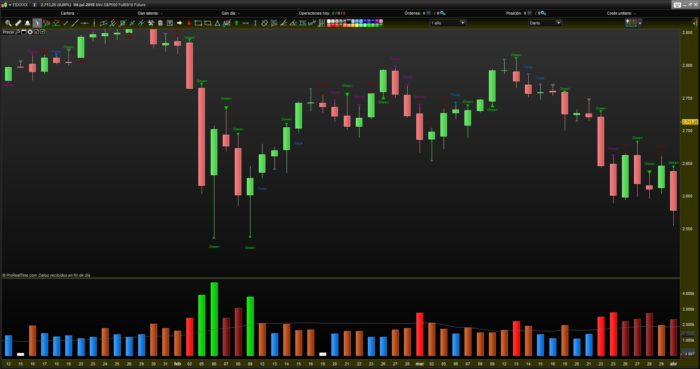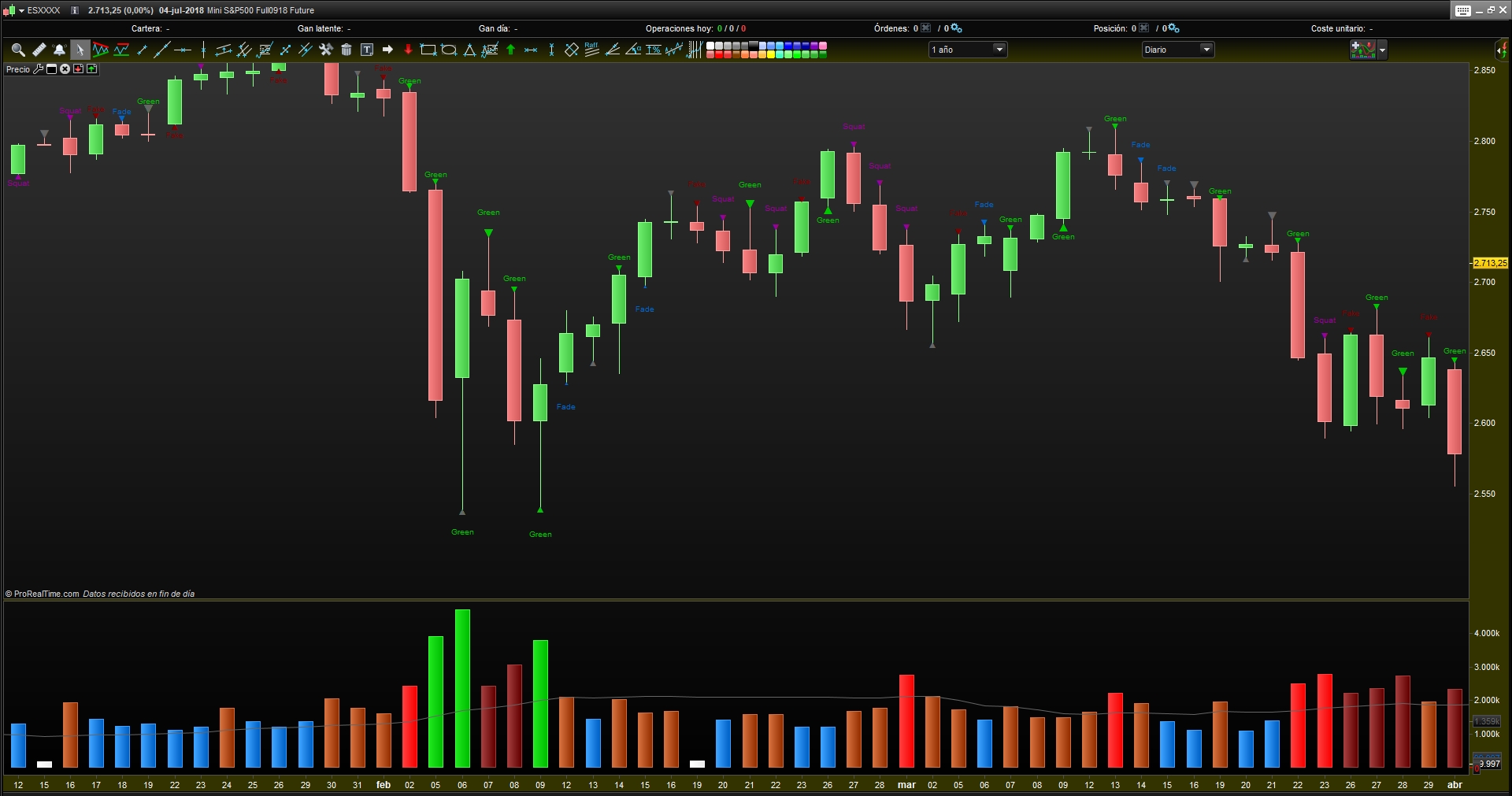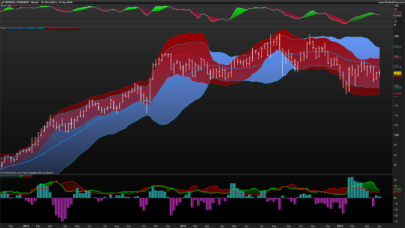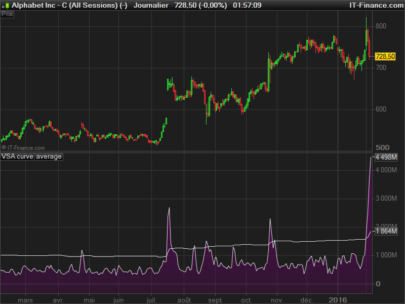Another method of studying Price and Volume by Bill Williams Profitunity
The Bill Williams Profitunity provides a unique way of quantifying price movement relative to volume. At the heart of it is the Market Facilatation Index (MFI). The MFI is the bar’s range (high – low) divided by the volume. Using the MFI, each bar has a mathematical relationship of the price activity versus the volume. In essence, the MFI is a measurement of market efficiency, tracking how much movement has occurred in price relative to volume. By comparing the MFI for the current bar to the previous bar’s, you can gauge the current bar’s ability to facilitate price to the previous bar’s ability. The Bill Williams Profitunity can be used on any period from daily bars to monthly bars.
The MFI as a stand-alone indicator has little value. However, by comparing the current bar’s MFI and volume with the previous bar’s MFI and volume, a very tradable system emerges.
Williams defines the four possible combinations of MFI and volume as follows. A plus sign means the current bar’s value is greater than the previous bar’s value. A minus sign means the current bar’s value is less than the previous bar’s value.
Volume MFI Label:
- Green //Green
- Fade //Blue
- Fake //Red
- Squat //Violet
Green. This bar shows an increase in volume and the MFI relative to the previous bar. Hence, there is price movement, and the MFI is larger for this bar than that for the previous bar. Further, more players are entering the market as signaled by the increase in volume. This activity in the futures market means that off-floor traders are very active. In addition, the price action is directional–that is, the market is moving in one direction due to the involvement of new traders putting on new positions. This is the kind of day that you would already want to have a trade on in the same direction.
Fade. This bar shows a decrease in volume and the MFI relative to the previous bar. The market has slowed and there is a minor amount of activity as indicated by the low volume. This type of day is called a fade, as the traders’ interest in the market by this point is fading. Often, this sort of day happens at the end of a trend. The market has simply reached a point where nobody is willing to establish any new positions. At this point the market appears to be suffering from a certain amount of boredom. Keep in mind, however, that out of this market condition, a new trend could emerge.
Fake. This bar shows a decrease in volume but an increase in the MFI. This condition means that the market is moving more relative to the previous bar (the greater MFI), but the lack of volume is evidence that there is no new participation. The price action may be driven by just the traders in the pit and is not attracting new players from the outside. Williams has an hypothesis, that the traders in the pit may be just strong enough to push the market to price levels where there are many stop orders resting in the hands of the brokers, hence faking out the off-floor traders.
Squat. This bar shows an increase in volume relative to the previous bar, but the MFI is lower. The increase in volume indicates heavy activity, but the decrease in the MFI indicates that the market is unable to make any real headway. Volume increased, the trend has stalled and the price movement has stopped. This price action usually, but not always occurs prior to an important move in the opposite direction. This type of bar is called a squat bar because the market appears to be squatting prior to a breakout. Often, the breakout of such a bar will indicate whether this squat is a trend reversal squat or a trend continuation squat.
|
1 2 3 4 5 6 7 8 9 10 11 12 13 14 15 16 17 18 19 20 21 22 23 24 25 26 27 28 29 30 31 32 33 34 35 36 37 38 39 40 41 42 43 44 45 46 47 48 49 50 51 52 53 54 55 56 57 58 59 60 61 62 63 64 65 66 67 68 69 70 71 72 73 74 75 76 77 78 79 80 81 82 83 84 85 86 87 88 89 90 91 92 93 94 95 96 97 98 99 100 101 102 103 104 105 106 107 108 109 110 111 112 113 114 115 116 117 118 119 120 121 122 123 124 125 126 127 128 129 130 131 132 133 134 135 136 137 138 139 140 141 142 143 144 145 146 147 148 149 150 151 152 153 154 155 156 157 158 159 160 161 162 163 164 165 166 167 168 169 170 171 172 173 174 175 176 177 178 179 180 181 182 183 |
/////////////////////////////////////////////////////////////////////////////// atr = averagetruerange[10](close)*0.5 Vol=volume linea=4 Lineb=0.0001 smavol = average[500](vol) stdvol =std[500](vol) sma = average[50](vol) If stdvol > linea then av=(smavol +linea*stdvol) else av=0 endif if stdvol> lineb then bv=(smavol +lineb*stdvol) else bv=0 endif MFI0 = (high - low) / volume MFI1 = (high[1] - low[1]) / volume[1] MFIplus = MFI0 > MFI1 MFIminus = MFI0 < MFI1 meanplus = (high + low) /2 > high[1] meanminus = (high + low) /2 < high[1] volplus = volume > volume[1] volminus = volume < volume[1] b13 = open < (high + low) /2 and close > (high + low) /2 and close > open b31 = open > (high + low) /2 and close < (high + low) /2 and close < open a0 = open > (high + low) /2 and close > (high + low) /2 and close > open if a0 then DrawText("▴",barindex,low,SansSerif,Standard,20)coloured(102,102,102) endif b0= open < (high + low) /2 and close < (high + low) /2 and close > open if b0 then DrawText("▾",barindex,high,SansSerif,Standard,20)coloured(102,102,102) endif c0 = open < (high + low) /2 and close < (high + low) /2 and close < open if c0 then DrawText("▾",barindex,high,SansSerif,Standard,30)coloured(102,102,102) endif d0 = open > (high + low) /2 and close > (high + low) /2 and close < open if d0 then DrawText("▾",barindex,high,SansSerif,Standard,30)coloured(102,102,102) endif ////////////////////////////////////////////////////////////////////////////////////////////////////////////// a0 = open > (high + low) /2 and close > (high + low) /2 and close > open and vol > av[1] if a0 then DrawText("▴",barindex,low,SansSerif,Standard,20)coloured(0,200,0) DrawText("Green",barindex,low-atr/2,SansSerif,Standard,10)coloured(0,200,0) endif b0= open < (high + low) /2 and close < (high + low) /2 and close > open and vol < bv[1] if b0 then DrawText("▾",barindex,high,SansSerif,Standard,20)coloured(0,102,204) DrawText("Fade",barindex,High+atr/2,SansSerif,Standard,10)coloured(0,102,204) endif c0 = open < (high + low) /2 and close < (high + low) /2 and close < open and vol > sma[1] if c0 then DrawText("▾",barindex,high,SansSerif,Standard,30)coloured(0,200,0) DrawText("Green",barindex,high+atr/2,SansSerif,Standard,10)coloured(0,200,0) endif d0 = open > (high + low) /2 and close > (high + low) /2 and close < open and vol > sma[1] if d0 then DrawText("▾",barindex,high,SansSerif,Standard,30)coloured(153,0,153) DrawText("Squat",barindex,high+atr/2,SansSerif,Standard,10)coloured(153,0,153) endif a= meanplus and b13 and volplus and MFIplus if a then DrawText("▴",barindex,low,SansSerif,Standard,30)coloured(0,200,0) DrawText("Green",barindex,low-atr/4,SansSerif,Standard,10)coloured(0,200,0) endif b = meanplus and b13 and volminus and MFIminus if b then DrawText("▴",barindex,low,SansSerif,Standard,10)coloured(0,102,204) DrawText("Fade",barindex,low-atr/2,SansSerif,Standard,10)coloured(0,102,204) endif c = meanplus and b13 and volminus and MFIplus if c then DrawText("▴",barindex,low,SansSerif,Standard,20)coloured(128,0,0) DrawText("Fake",barindex,low-atr/2,SansSerif,Standard,10)coloured(128,0,0) endif d = meanplus and b13 and volplus and MFIminus if d then DrawText("▴",barindex,low,SansSerif,Standard,20)coloured(153,0,153) DrawText("Squat",barindex,low-atr/2,SansSerif,Standard,10)coloured(153,0,153) endif e = meanminus and b13 and volplus and MFIplus if e then DrawText("▾",barindex,high,SansSerif,Standard,20)coloured(0,200,0) DrawText("Green",barindex,high+atr/4,SansSerif,Standard,10)coloured(0,200,0) endif f = meanminus and b13 and volminus and MFIminus if f then DrawText("▾",barindex,high,SansSerif,Standard,20)coloured(0,102,204) //blue DrawText("Fade",barindex,high+atr/2,SansSerif,Standard,10)coloured(0,102,204) endif g = meanminus and b13 and volminus and MFIplus if g then DrawText("▾",barindex,high,SansSerif,Standard,20)coloured(128,0,0) DrawText("Fake",barindex,high+atr/2,SansSerif,Standard,10)coloured(128,0,0) endif j = meanminus and b13 and volplus and MFIminus if j then DrawText("▾",barindex,high,SansSerif,Standard,20)coloured(153,0,153) DrawText("Squat",barindex,high+atr/2,SansSerif,Standard,10)coloured(153,0,153) endif i = meanplus and b31 and volplus and MFIplus if i then DrawText("▴",barindex,low,SansSerif,Standard,20)coloured(0,200,0) DrawText("Green",barindex,low-atr/4,SansSerif,Standard,10)coloured(0,200,0) endif o = meanplus and b31 and volminus and MFIminus if o then DrawText("▴",barindex,low,SansSerif,Standard,20)coloured(0,102,204)//blue DrawText("Fade",barindex,low-atr/2,SansSerif,Standard,10)coloured(0,102,204) endif t = meanplus and b31 and volminus and MFIplus if t then DrawText("▴",barindex,low,SansSerif,Standard,20)coloured(128,0,0) DrawText("Fake",barindex,low-atr/2,SansSerif,Standard,10)coloured(128,0,0) endif aa = meanplus and b31 and volplus and MFIminus if aa then DrawText("▴",barindex,low,SansSerif,Standard,20)coloured(153,0,153) DrawText("Squat",barindex,low-atr/2,SansSerif,Standard,10)coloured(153,0,153) endif bb = meanminus and b31 and volplus and MFIplus if bb then DrawText("▾",barindex,high,SansSerif,Standard,20)coloured(0,200,0) DrawText("Green",barindex,high+atr/4,SansSerif,Standard,10)coloured(0,200,0) endif cc = meanminus and b31 and volminus and MFIminus if cc then DrawText("▾",barindex,high,SansSerif,Standard,20)coloured(0,102,204) //blue DrawText("Fade",barindex,high+atr/2,SansSerif,Standard,10)coloured(0,102,204) endif dd = meanminus and b31 and volminus and MFIplus if dd then DrawText("▾",barindex,high,SansSerif,Standard,20)coloured(128,0,0) DrawText("Fake",barindex,high+atr/2,SansSerif,Standard,10)coloured(128,0,0) endif ee = meanminus and b31 and volplus and MFIminus if ee then DrawText("▾",barindex,high,SansSerif,Standard,20)coloured(153,0,153) DrawText("Squat",barindex,high+atr/2,SansSerif,Standard,10)coloured(153,0,153) endif drawcandle(open,high,low,close) return |
Share this
No information on this site is investment advice or a solicitation to buy or sell any financial instrument. Past performance is not indicative of future results. Trading may expose you to risk of loss greater than your deposits and is only suitable for experienced investors who have sufficient financial means to bear such risk.
ProRealTime ITF files and other attachments :PRC is also on YouTube, subscribe to our channel for exclusive content and tutorials








Improved version in the Blog
https://www.tiburonesdealetacorta.com/2018/07/indicador-bill-williams-profitunity.html
Thanks for sharing this. I understand the 4 conditions, but can you explain the following please?
– how is labelling above the bar different from below the bar?
– what does a large arrow with no other labelling mean?
Regards.
From the updated version, here is a screenshot. The first bar has “Green” text with a large purple up arrow. The second bar has “Green” text with a small green up arrow.
Sorry, it’s a file error.
I have already uploaded a new File.
https://www.tiburonesdealetacorta.com/2018/07/indicador-bill-williams-profitunity.html
Thank you; the new version looks better. I wonder if you’d mind explaining what it means when the arrow is above or below the candle?
Here you have the documentation of the indicator
https://en.wikipedia.org/wiki/Market_facilitation_index
https://www.tiburonesdealetacorta.com/search/label/Indicador%20Bill%20Williams%20Profitunity
Hi TAC Bolsa, thanks for providing this interesting indicator. I’m wondering how would you adjust the code so that it draws a histogram along the horizontal axis instead of candles? Cheers.
remove the ATR, and drawcandle (open, high, low, close)
substitute everything
DrawText (“▾”, barindex, high, SansSerif, Standard, 20) colored (200,0,0)
DrawText (“”, barindex, high + atr / 2, SansSerif, Standard, 10) colored (200,0,0)
signal = -1
substitute everything
DrawText (“▴”, barindex, low, SansSerif, Standard, 20) colored (153,0,153)
DrawText (“”, barindex, low-atr / 2, SansSerif, Standard, 10) colored (153,0,153)
signal = 1
return signal
Thanks, I have tried altering and adding my amended code many times but without getting the indicator to work.. I’m not sure I understand what you meant by, “substitute everything”?
I’ve removed:
atr = averagetruerange[10](close)*0.5 and
drawcandle(open,high,low,close) and replaced with “return signal”
I’ve removed all reference to atr within the code so a line of code now reads
e.g:
“Fake”,barindex,high…, (instead of the original “Fake”,barindex,high+atr/2… ).
I have done that for all atr’s so they all now read as either “low,” (instead or “low+atr/2”), or “high,” (instead of “high+atr/2″). (I appreciate that the apostrophes ” ” only surround the words like Fake etc)
I have placed “signal = 1” or “signal = -1” for every condition from (a) to (ee).
E.g:
ee = meanminus and b31 and volplus and MFIminus
if ee then
DrawText(“▾”,barindex,high,SansSerif,Standard,20)coloured(153,0,153)
DrawText(“Squat”,barindex,high,SansSerif,Standard,10)coloured(153,0,153)
signal = -1
endif
Any ideas what I am doing wrong?
Thanks again,
substitute / removed everything
DrawText
I’m sorry I don’t understand. Perhaps you could explain in your language and I can try Google translate?
Or perhaps write two lines of this code as they are meant to be for the indicator to function as it was originally designed along the x-axis? Thanks again!
Este es el código original..
Nada que ver con la versión 1,1 del blog donde se mejora con el cumulative Delta en el Volumen.
//Bill Williams Profitunity
MFI0 = RANGE*(high – low) / volume
MFI1 = RANGE*(high[1] – low[1]) / volume[1]
MFIplus = MFI0 > MFI1
MFIminus = MFI0 high[1]
meanminus = (high + low) /2 volume[1]
volminus = volume < volume[1]
b13 = open (high + low) /2 and close > open[1]
b31 = open > (high + low) /2 and close < (high + low) /2 and close < open[1]
//////////////////////////////////////////////////////////////////////////////////////////////////////////////
a= meanplus and b13 and volplus and MFIplus
if a then
signal =1
endif
b = meanplus and b13 and volminus and MFIminus
if b then
signal =1
endif
c = meanplus and b13 and volminus and MFIplus
if c then
signal =1
endif
d = meanplus and b13 and volplus and MFIminus
if d then
signal =1
endif
e = meanminus and b13 and volplus and MFIplus
if e then
signal =1
endif
f = meanminus and b13 and volminus and MFIminus
if f then
signal =1
endif
g = meanminus and b13 and volminus and MFIplus
if g then
signal =1
endif
j = meanminus and b13 and volplus and MFIminus
if j then
signal =1
endif
///////////////////////////////////////////////////////////////////////////////////////////////////////////////
i = meanplus and b31 and volplus and MFIplus
if i then
signal =-1
endif
o = meanplus and b31 and volminus and MFIminus
if o then
signal =-1
endif
t = meanplus and b31 and volminus and MFIplus
if t then
signal =-1
endif
aa = meanplus and b31 and volplus and MFIminus
if aa then
signal =-1
endif
bb = meanminus and b31 and volplus and MFIplus
if bb then
signal =-1
endif
cc = meanminus and b31 and volminus and MFIminus
if cc then
signal =-1
endif
dd = meanminus and b31 and volminus and MFIplus
if dd then
signal =-1
endif
ee = meanminus and b31 and volplus and MFIminus
if ee then
signal =-1
endif
if signal =1 then
r=0
g=128
b=0
else
r=128
g=0
b=0
endif
return signal coloured (r,g,b) style(histogram)
Thanks for providing the code @TAC Bolsa.
Do you think this code below is doing what Bill Williams intended the price / volume indicator to do?
(I am not a coder, I put this together from 3 different versions)
The code will not “add” so here it is:
Bill Williams’ Price/Volume Indicator:
//Bill Williams’ Price/Volume Indicator
MFI = RB / V
RB = Range //high-low in points
V = Volume
MFI0 = Range / Volume
MFI1 = (Range[1]) / Volume[1]
MFIPlus = MFI0 > MFI1
MFIMinus = MFI0 Volume[1]
VolMinus = Volume < Volume[1]
if MFIPlus and VolPlus then
MFI1=MFI
MFI2=0
MFI3=0
MFI4=0
elsif MFIMinus and VolMinus then
MFI1=0
MFI2=MFI
MFI3=0
MFI4=0
elsif MFIPlus and VolMinus then
MFI1=0
MFI2=0
MFI3=MFI
mfi4=0
elsif MFIMinus and VolPlus then
MFI1=0
MFI2=0
MFI3=0
MFI4=MFI
endif
return MFI1 coloured (0,255,0) as "Follow Trend Green", MFI2 coloured (0,0,255) as "Fade Blue", MFI3 coloured (255,0,0) as "Fake Red", MFI4 coloured (255,0,255) as "Squat Violet"
// More info:
// http://analyzerxl.com/webhelp/BulkQuotesXL%20Pro%20Online%20Help/scr/HTMLs/TA_Library/BillWilliamsProfitunity.htm
// https://en.wikipedia.org/wiki/Market_facilitation_index
Thanks but the links broken and I can’t find it by searching for parts of the URL?
I am not sure why you posted an image of Williams Price / Volume Indicator and then gave a posted code that is not Williams code? Your code makes it harder to actually read the volume changes because your indicator floats (and references ATR) and is not based on the x-axis.
Thanks again for your input.
You confuse the things “Bacon with speed” ..
The links work perfectly.
The indicators are reviewed and validated by their authors or active representative.
What you have is an evolution of an indicator validated by its authors ..
What Ulted seeks is for payment .. and for them if you want it you can pay it in other platforms …
You have to know how to differentiate between an evolution of an original indicator.
Instead of criticizing the work, you should develop it yourself.
What you are looking for is the Market Facilitation Index (MFI), which has nothing to do with this indicator.
Now I understand why I wanted to convert it into Histogram …
First you should be informed of the differences of one or the other indicator to request or make changes … if NO you know the bases of the indicators.
“Bacon with speed” is a new one on me,
Apologies, the link was not working on my iphone but works okay on my Macbook. Thanks.
I am not criticising, and there is no need to take any offence, I am simply stating a fact. Where is this image at the top of this page that you posted taken from? Is it Williams original indicator or an evolution by a programmer, because to me, it looked exactly like the Williams Price/Vol indicator that I had seen on the web and which I assumed was the code I was downloading in the in the itf file.
But as I later realised it was not, as you clearly have explained above and that this code on this page is for an evolution of Williams’ code.
Hence my request for a histogram fixed to the x-axis like WIlliams’ indicator, so it is very easy to see volume differences — That mismatching of the images was confusing but it’s no big deal, really. If you had posted the floating ATR candlesticks image I wouldn’t have downloaded it and then spent hours trying to configure it to be like WIlliams’ intended it to be! I hope I got it right though but you have not said of the code I posted is good? Anyway, I was simply after the original code.
Best,
Bard
I already published it … in prorealcode …
Next time … request a change of programming from the indicator to prorealcode ..
I already published it … in prorealcode …
https://www.prorealcode.com/prorealtime-indicators/market-facilitation-index-bill-williams/